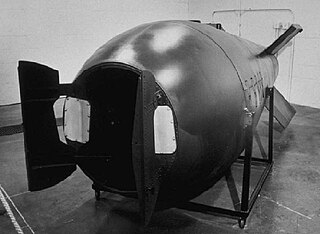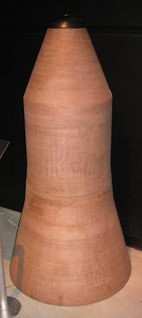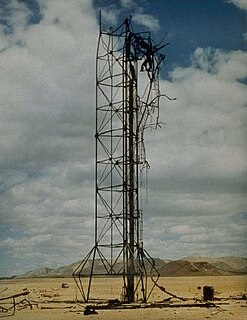
A warhead is the explosive or toxic material that is delivered by a missile, rocket, or torpedo. It is a type of bomb.
A neutron bomb, officially defined as a type of enhanced radiation weapon (ERW), is a low-yield thermonuclear weapon designed to maximize lethal neutron radiation in the immediate vicinity of the blast while minimizing the physical power of the blast itself. The neutron release generated by a nuclear fusion reaction is intentionally allowed to escape the weapon, rather than being absorbed by its other components. The neutron burst, which is used as the primary destructive action of the warhead, is able to penetrate enemy armor more effectively than a conventional warhead, thus making it more lethal as a tactical weapon.

Nuclear weapon designs are physical, chemical, and engineering arrangements that cause the physics package of a nuclear weapon to detonate. There are three existing basic design types:

The WE.177, originally styled as WE 177, and sometimes simply as WE177, was a series of tactical and strategic nuclear weapons with which the Royal Navy (RN) and the Royal Air Force (RAF) were equipped. It was the primary air-dropped nuclear weapon in the United Kingdom from the late 1960s into the 1990s.
Red Snow was a British thermonuclear weapon, based on the US W28 design used in the B28 thermonuclear bomb and AGM-28 Hound Dog missile. The US W28 had yields of 70, 350, 1,100 and 1,450 kilotonnes of TNT and while Red Snow yields are still classified, declassified British documents indicate the existence of "kiloton Red Snow" and "megaton Red Snow" variants of the weapon, suggesting similar yield options, while other sources have suggested a yield of approximately 1 megatonne of TNT (4.2 PJ).
Variable yield, or dial-a-yield, is an option available on most modern nuclear weapons. It allows the operator to specify a weapon's yield, or explosive power, allowing a single design to be used in different situations. For example, the Mod-10 B61 bomb had selectable explosive yields of 0.3, 5, 10 or 80 kilotons, depending on how the ground crew set a dial inside the casing when it was loaded onto an aircraft.

A boosted fission weapon usually refers to a type of nuclear bomb that uses a small amount of fusion fuel to increase the rate, and thus yield, of a fission reaction. The neutrons released by the fusion reactions add to the neutrons released due to fission, allowing for more neutron-induced fission reactions to take place. The rate of fission is thereby greatly increased such that much more of the fissile material is able to undergo fission before the core explosively disassembles. The fusion process itself adds only a small amount of energy to the process, perhaps 1%.

A thermonuclear weapon, fusion weapon or hydrogen bomb is a second-generation nuclear weapon design. Its greater sophistication affords it vastly greater destructive power than first-generation nuclear bombs, a more compact size, a lower mass, or a combination of these benefits. Characteristics of nuclear fusion reactions make possible the use of non-fissile depleted uranium as the weapon's main fuel, thus allowing more efficient use of scarce fissile material such as uranium-235 or plutonium-239. The first full-scale thermonuclear test was carried out by the United States in 1952; the concept has since been employed by most of the world's nuclear powers in the design of their weapons.
The W50 was an American thermonuclear warhead used on the MGM-31 Pershing short range nuclear missile. It was also used on the LIM-49 Nike Zeus anti-ballistic missile, but this program was cancelled before deployment. The W50 was developed by the Los Alamos National Laboratory.
The W52 was a thermonuclear warhead developed for the MGM-29 Sergeant short-range ballistic missile used by the United States Army from 1962 to 1977. The W52 is 24 inches (61 cm) in diameter and 57 inches (140 cm) long, and weighted 950 pounds (430 kg). It had a yield of 200 kilotons. A total of 300 W52 warheads were produced.
The Tsetse was a small American nuclear bomb developed in the 1950s that was used as the primary in several US thermonuclear bombs and as a small stand-alone weapon of its own.

The Mark 5 nuclear bomb and W5 nuclear warhead were a common core American nuclear weapon design, designed in the early 1950s and which saw service from 1952 to 1963.

The W59 was an American thermonuclear warhead used on some Minuteman I ICBM missiles from 1962 to 1969, and planned to be used on the cancelled GAM-87 Skybolt air-launched ballistic missile.
The W34 was an American nuclear bomb developed and deployed during the mid-1960s.
The W30 was an American nuclear warhead used on the RIM-8 Talos surface-to-air missile and the Tactical Atomic Demolition Munition (TADM).
Kinglet was a boosted fission primary used in several American thermonuclear weapons.

The uranium hydride bomb was a variant design of the atomic bomb first suggested by Robert Oppenheimer in 1939 and advocated and tested by Edward Teller. It used deuterium, an isotope of hydrogen, as a neutron moderator in a uranium-deuterium ceramic compact. Unlike all other fission-based weapon types, the concept relies on a chain reaction of slow nuclear fission. Bomb efficiency was adversely affected by the cooling of neutrons since the latter delays the reaction, as delineated by Rob Serber in his 1992 extension of the original Los Alamos Primer.
The Robin was the common design nuclear fission bomb core for several Cold War designs for American nuclear and thermonuclear weapons, according to researcher Chuck Hansen.
ET.317 was a thermonuclear weapon of the British Royal Navy, developed for the UK version of the UGM-27 Polaris missile.